

DOE Fundamentals Handbook, Volume 2 of 2. Department of Energy, Instrumantation and Control. Martin, James E., Physics for Radiation Protection 3rd Edition, Wiley-VCH, 4/2013.Stabin, Michael G., Radiation Protection and Dosimetry: An Introduction to Health Physics, Springer, 10/2010.Knoll, Glenn F., Radiation Detection and Measurement 4th Edition, Wiley, 8/2010.Otherwise, leakage current induced noise destroys the energy resolution of the detector. Because germanium has relatively low band gap, these detectors must be cooled in order to reduce the thermal generation of charge carriers (thus reverse leakage current) to an acceptable level. In doped material the signal to noise ratio (S/N) would be even smaller.
#Signal to noise ratio free
The addition of 0.001% of arsenic (an impurity) donates an extra 10 17 free electrons in the same volume and the electrical conductivity is increased by a factor of 10,000. As can be seen, the signal to noise ratio (S/N) would be minimal. Note that, a 1 cm 3 sample of pure germanium at 20 ☌ contains about 4.2×10 22 atoms, but also contains about 2.5 x 10 13 free electrons and 2.5 x 10 13 holes. Since thermal excitation results in the detector noise, active cooling is required for some types of semiconductors (e.g. It strongly depends on the E gap (a distance between valence and conduction band), which is very low for germanium (Egap= 0.67 eV). It is caused by impurities, irregularity in structure lattice or by dopant. But in germanium-based detectors at room temperature, thermal excitation is dominant. Particle passing through the detector ionizes the atoms of semiconductor, producing the electron-hole pairs. This value is minor in comparison the total number of free carriers in a 1 cm 3 intrinsic semiconductor. Total absorption of a 1 MeV photon produces around 3 x 10 5 electron-hole pairs. Signal-to-Noise Ratio – Germanium Detectors Signal-to-noise ratio, SNR, is a measure used in science and engineering that compares the electrical output signal to the electrical noise generated in the cable run or in the instrumentation. However it is a small signal, this signal can be amplified, and then recorded using standard electronics. The collection of these ions will produce a charge on the electrodes and an electrical pulse across the detection circuit. Under the influence of the electric field, the positive ions will move toward the negatively charged electrode (outer cylinder), and the negative ions (electrons) will migrate toward the positive electrode (central wire). As ionizing radiation enters the gas between the electrodes, a finite number of ion-pairs are formed. The anode is at a positive voltage with respect to the detector wall. As a general rule, the center wire is the positive electrode (anode) and the outer cylinder is the negative electrode (cathode), so that (negative) electrons are attracted to the center wire and positive ions are attracted to the outer cylinder. Basic gaseous ionization detector consists of a chamber that is filled with a suitable medium (air or a special fill gas) that can be easily ionized. Once noise has become part of a signal, it can't be filtered or reduced.Detector of Ionizing Radiation – Geiger Tube The formula for calculating a signal-to-noise ratio in dB is: SNR = 20 x log (Signal/Noise). Signal-to-noise ratio is also frequently stated in decibels (dB). Signal-to-noise ratio is commonly expressed as a factor such as 20 to 1, 30 to 1, etc. The relationship between signal and noise is called the signal-to-nose ratio (SNR). The difference between the ideal signal that you expect and the real-world signal that you actually see is usually called noise. Sometimes, the output voltage will be a bit bigger than expected and sometimes, it will be a bit smaller. Due to temperature conditions, electronic interference, etc., sensors will not convert light 100% precisely. Unfortunately, ideal sensors (like all other electronic devices) do not exist. An ideal camera sensor would convert a known amount of light into an exactly predictable output voltage.


 0 kommentar(er)
0 kommentar(er)
